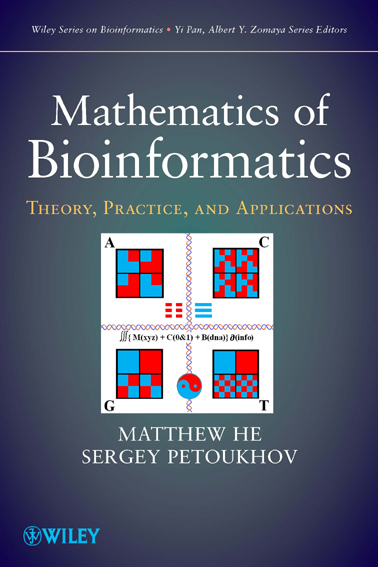Contact: spetoukhov@gmail.com

Symmetrical Analysis Techniques for Genetic Systems and Bioinformatics:
Advanced Patterns and Applications
Sergey Petoukhov
Russian Academy of Sciences, Moscow, Russia
Matthew He
Nova Southeastern University, Fort Lauderdale, USA
IGI Global
Hershey • London • Melbourne • Singapore
TABLE OF CONTENTS
PREFACE
AUTHORS
ACKNOWLEDGMENTS
SECTION I SYMMETRICAL ANALYSIS TECHNIQUES AND SYMBOLIC MATRICES OF MATRIX GENETICS
CHAPTER 1 GENETIC CODE: EMERGENCE OF SYMMETRICAL PATTERN, BEGINNINGS OF MATRIX
GENETICS
1.1 Introduction and background
1.2 Significance of symmetrical patterns for biology, molecular genetics and
bioinformatics
1.3 Information science, noise immunity and the matrix approach to the genetic
code
1.4 The basic structures of the genetic code
1.5 The binary sub-alphabets of the genetic alphabet for numbering the multiplets
in genetic matrices
1.6 The natural system of numbering the genetic multiplets
1.7 The matrix numbering the genetic multiplets and matrices of diadic shifts
1.8 Future trends and conclusion
REFERENCES
CHAPTER 2 SYMMETRIES OF DEGENERACY OF THE VERTEBRATE MITOCHONDRIAL CODE IN
THE MATRIX FORM
Introduction and background
2.1 Peculiarities of degeneracy of the genetic code
2.2 Symmetrical properties of genetic matrices of triplets under permutations
of positions inside triplets
2.3 Genomatrices with the property of the tetra-self-reproducing
2.4 Symmetrical properties of genetic matrices under alphabetic permutations
in the set of 64 triplets
2.5 Future trends and conclusion
REFERENCES
CHAPTER 3 BIOLOGICAL EVOLUTION OF DIALECTS OF THE GENETIC CODE
3.1 Introduction and background
3.2 Phenomenological rules of evolution of known dialects of genetic codes
3.3 The chronocyclic conception and the degeneracy in the dialects of the genetic
code
3.4 Why 20 amino-acids?
3.5 Future trends and conclusion
REFERENCES
SECTION II SYMMETRICAL ANALYSIS TECHNIQUES AND NUMERIC MATRICES OF THE GENETIC CODE
CHAPTER 4 NUMERIC GENOMATRICES OF HYDROGEN BONDS, THE GOLDEN SECTION, MUSICAL
HARMONY AND AESTHETIC FEELINGS
4.1 Introduction and background
4.2 Numeric genomatrices of hydrogen bonds
4.3 The numeric genomatrices and the golden section
4.4 The genomatrices, musical harmony and Pythagorean musical scale
4.5 A scale of the golden wurf, music and Fibonacci numbers
4.6 On harmony of a scale of protons in the set of amino-acids
4.7 Future trends and conclusion
REFERENCES
CHAPTER 5 GENETIC CODE AND STOCHASTIC MATRICES
5.1 Introduction and background
5.2 Genetic code, Hamming distance, and stochastic matrices
5.3 Genetic code, attributive mapping, and stochastic matrices
5.4 Genetic code, power of matrices, and stochastic matrices
5.5 Future trends and conclusion
REFERENCES
CHAPTER 6 THE GENETIC CODE, HADAMARD MATRICES, NOISE IMMUNITY AND QUANTUM COMPUTERS
6.1 Introduction and background
6.2 The genetic code and Hadamard matrices
6.3 About importance of amino-groups NH2
6.4 Genetic informatics, Hadamard matrices and quantum computers
6.5 Why does the genetic alphabet consist of four letters?
6.6 Cyclic shifts, cyclic codes and the principle of molecular economy in genetic
informatics
6.7 Future trends and conclusion
REFERENCES
SECTION III ALGEBRAS OF GENETIC CODES
CHAPTER 7 GENOMATRICES AND THE GENETIC OCTET YIN-YANG-ALGEBRAS
7.1 Introduction and background
7.2 The genetic octet matrix as the matrix form of presentation of the octet
algebra
7.3 The alphabetic algorithm of the Yin-Yang-digitization of 64 triplets
7.4 The genomatrix YY8 as the element of the octet Yin-Yang-algebra
7.5 The structural analogies between the genomatrix [C A; G U](3) and the matrix
YY8
7.6 The six kinds of the genetic octet Yin-Yang-algebras connected with permutations
of positions in triplets
7.7 The genetic Yin-Yang octets as “double genoquaternions”
7.8 The comparison between the classical vector calculation and the genovector
calculation
7.9 The parametric reduction of the genetic octet Yin-Yang-algebra to the 4-dimensional
algebra of tetrions
7.10 About genetic mechanics and the idea by Pythagoras
7.11 What is life from the viewpoint of algebra? The problem of algebraization
of
bioinformatics and biology
7.12 Solutions and recommendations
7.13 Future trends and conclusion
REFERENCES
CHAPTER 8 THE EVOLUTION OF THE GENETIC CODE FROM THE VIEWPOINT OF THE GENETIC
8-DIMENSIONAL YIN-YANG-ALGEBRA
8.1 Introduction and background
8.2 The comparison analysis and phenomenological rules of dialects of the genetic
code
8.3 The molecular-sexual approach in molecular genetics
8.4 The example of the pairs of histones
8.5 Whether an unknown quantum mechanical factor of a “sexual attraction” among
genetic molecules exists?
8.6 The analysis of the insulin structure as the simplest example
8.7 Some applications of results of matrix genetics in bioinformatics and algebraic
biology.
8.8 Solutions and recommendations
8.9 Future trends and conclusion
REFERENCES
CHAPTER 9 MULTIDIMENSIONAL NUMBERS AND THE GENOMATRICES OF HYDROGEN BONDS
Introduction and background
9.1 The hyperbolic matrions as a special kind of hypercomplex numbers
9.2 The circular matrions
9.3 The rules of eigenvalues of matrices of circular matrions
9.4 Circular matrions and the series of natural numbers
9.5 Solutions and recommendations
9.6 Future trends and conclusion
REFERENCES
SECTION IV CONNECTIONS OF MATRIX GENETICS WITH OTHER FIELDS OF SCIENCE AND CULTURE
CHAPTER 10 GENETIC SYSTEM, FIBONACCI NUMBERS AND PHYLLOTAXIS
LAWS
10.1 Introduction and background
10.2 Fibonacci’s matrices and biological laws of phyllotaxis
10.3 Additional facts about the golden section and matrices
10.4 Hadamard matrices, projective geometry and the golden wurf
10.5 Future trends and conclusion
REFERENCES
CHAPTER 11 PHYSIOLOGICAL CYCLES AND THEIR ALGEBRAIC MODELS IN MATRIX GENETICS
11.1 Introduction and background
11.2 Revealing new genetic algebras as a result of cyclic permutations of
genetic
elements
11.3 The oppositional category of genetic Yin-Yang-matrices
11.4 Generative and suppressive properties of yin-yang-matrices of the two
categories
11.5 Joining of the idea by Pythagoras and the idea of cyclic changes: about
cellular
automata, neurocomputers and a notion of biological time
11.6 Solutions and recommendations
11.7 Future trends and conclusion
REFERENCES
CHAPTER 12 MATRIX GENETICS AND CULTURE
12.1 Introduction and background
12.2 Genetic code and linguistics
12.3 The genetic code, a color perception and a color communication
12.4 Parallels between patterns of the genetic code and patterns of "I
Ching"
12.5 Musical harmony in the matrices of the genetic code and of “I Ching”
12.6 Future trends and conclusion
REFERENCES
INDEX
MATHEMATICS OF BIOINFORMATICS
-THEORY, PRACTICE, AND APPLICATIONS
Matthew He and Sergey Petoukhov
Wiley Book Series on Bioinformatics, 2010

TABLE OF CONTENTS
Preface
Acknowledgement
Chapter 1 Bioinformatics and Mathematics
§
1.1 Introduction
§
1.2 Genetic Code and Mathematics
§
1.3 Mathematical Background
§
1.4 Converting Data to Knowledge
§
1.5 Big Picture: Informatics
§
1.6 Challenges and Perspectives
References
Chapter 2 Genetic Codes, Matrices, and Symmetrical Techniques
§
2.1 Introduction
§
2.2 Matrix Theory and Symmetry Preliminaries
§
2.3 Genetic Codes and Matrices
§
2.4 Genetic Matrices, Hydrogen Bonds and the Golden Section
§
2.5 Symmetrical Patterns, Molecular Genetics and Bioinformatics
§
2.6 Challenges and Perspectives
References
Chapter 3 Biological Sequences, Sequence Alignment, and Statistics
§
3.1 Introduction
§
3.2 Mathematical Sequences
§
3.3 Sequence Alignment
§
3.4 Sequence Analysis and Further Discussions
§
3.5 Challenges and Perspectives
References
Chapter 4 Structures of DNA and Knot Theory
§
4.1 Introduction
§
4.2 Knot Theory Preliminaries
§
4.3 DNA Knots and Links
§
4.4 Challenges and Perspectives
References
Chapter 5 Protein Structures, Geometry, and Topology
§
5.1 Introduction
§
5.2 Computational Geometry and Topology Preliminaries
§
5.3 Protein Structures and Prediction
§
5.4 Statistical Approach and Discussions
§
5.5 Challenges and Perspectives
References
Chapter 6 Biological Networks and Graph Theory
§
6.1 Introduction
§
6.2 Graph Theory Preliminaries and Network Topology
§
6.3 Models of Biological Networks
§
6.4 Challenges and Perspectives
References
Chapter 7 Biological Systems, Fractals, and Systems Biology
§
7.1 Introduction
§
7.2 Fractal Geometry Preliminaries
§
7.3 Fractal Geometry in Biological Systems
§
7.4 Systems Biology and Perspectives
§
7.5 Challenges and Perspectives
References
Chapter 8 Matrix Genetics, Hadamard Matrix, and Algebraic Biology
§
8.1 Introduction
§
8.2 Genetic Matrices and the Degeneracy of the Genetic Code
§
8.3 The Genetic Code and Hadamard Matrices
§
8.4 Genetic Matrices and Matrices of Hypercomplex Numbers
§
8.5 Some Rules of Evolution of Variants of the Genetic Code
§
8.6 Challenges and Perspectives
References
Chapter 9 Bioinformatics, Living Systems and Cognitive Informatics
§
9.1 Introduction
§
9.2 Emerging Pattern, Dissipative Structure, and Evolving Cognition
§
9.3 Denotational Mathematics and Cognitive Computing
§
9.4 Challenges and Perspectives
References
Chapter 10 The Evolutionary Trends and Central Dogma of Informatics
§
10.1 Introduction
§
10.2 Evolutionary Trends of Informatics
§
10.3 Central Dogma of Informatics
§
10.4 Challenges and Perspectives
References
Appendix A Bioinformatics Notation and Databases
Appendix B Bioinformatics/Genetics/Timeline
Appendix C Bioinformatics Glossary
About Authors
Index